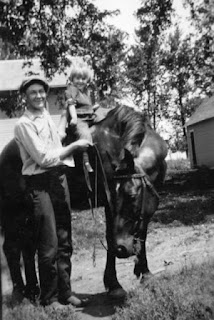Self and Story
I know the story of that little blonde girl, and also much about her self. In that little brain is growing one of the finest intellects I know. It is open, capacious, but also measured in its understanding of herself in reality, fully accepting herself as wife, mother and teacher. She uses her intelligence in the service of life, always. Which is astonishing, given how often we now see brains going off the rails, into the weeds, to some uncertain purpose.
Born so long after her siblings, my mother was indulged. She had a trunk of keepsakes which I loved to look at. The top of her wedding cake with its sugar doves, a pair of gold paper slippers, a red panne velvet dress in which one of my sisters was married, pearls and lovely cameo jewelry, plus a high school scrapbook with photos of film stars in it gave evidence of her young life. She told us that, during the depression, when her sister Esther, a teacher and later a school principal, got paid, she brought home a bag of Hershey’s kisses for her mother and sister.
The most astonishing thing is that Florence went to college. Most of my friend’s mothers did not have this opportunity in 1938. In college my mother met my father. They worked on the college newspaper together, but waited to get married until my father finished his seminary training. He was ordained as a pastor in the Lutheran church and he and Florence began their life in several northern parishes.
I showed up soon after, and within four years there were four little girls, quite a shock to a young mother. Among my early memories is coming upon her crying in the big rocker, two babies in her arms. Over the years, four more kids followed. We grew up in something of a litter, taking care of each other. Florence once described her mothering style as one of “benign neglect,” though I can hardly think of a school activity I was prevented from participating in. I do not remember her ever raising her voice, but she could cut through to what was important with a knife-edged sentence, and silence us with a look. On her bedside table, annotated and underlined, was Thomas a Kempis’ Imitation of Christ.
As we grew toward college age, mother became a high school librarian and teacher to help with the costs. All of her kids received higher education. Later she described her method of “following” her kids and their passionate pursuits, rather than trying to direct them.
A lover of nature, my mother’s summers at a cabin on a Minnesota lake were one of her great joys. When my dad was no longer alive, I remember, as an adult, coming up from swimming in the lake with my sister and watching through a window as she read into a microphone with her gentle, modulated voice the Lutheran magazine. The recording would be distributed to the blind.
This is my mother’s story, infused with her self. Like light, which is both wave and particle, we are both self and story. Our paradigmatic selves march along the syntagmatic timeline of our lives, of the world’s timeline. We exist both in time and outside of it. These strange dichotomies drive us.
The particular history of the world we enter marks us, as do the genetic gifts we have been given. We are about half nature and half nurture, according to the most recent research. Language makes us human, whether we express ourselves in words, colors, mathematics or music. My mother’s intelligence could be felt in her wholeness, in her contentment and dignity.
Florence did not live to see her great grandchildren, and I myself must content myself mainly with videos and photographs of them. It is thrilling to see these little seeds of self bloom. Their stories lie before them. Though they come into a world which seems to be fraught with danger, there is also much hope. And I believe that some of this comes from the life my mother led.
Conversely, I know the stories of many older people. I know that they have lives of high adventure, though Tik Tok culture may be disinterested in whether they manage to get from one room to another without falling. For myself, I begin to be thrilled when I get out alone, with my recalcitrant legs and fuzzy vision, taking public transportation to lunch with a friend!
Thus, as older people, our activities are more being than doing. We exist both in time and out of time. Comedy, usually dark, attends us. Tragedy too, and sometimes grace, as we march into the future. None of us will get out of this alive, as we know. Study of our stories, and of ourselves, however, repays the student. It is astonishing how much life can teach us! Perhaps the most recent technology has passed us by, but the core values of being human, of living in the service of life, or not, make us either exemplary or cautionary tales.
The story of this little girl, put on a horse by her brother, lives in my inner life as vividly as if she were still alive. It is, in fact, my story.



Comments
Post a Comment